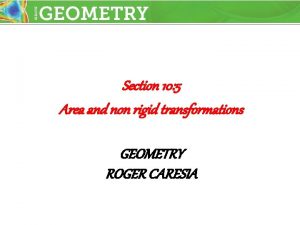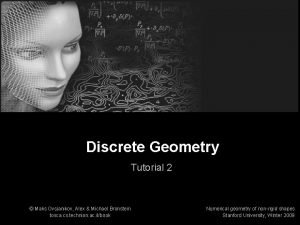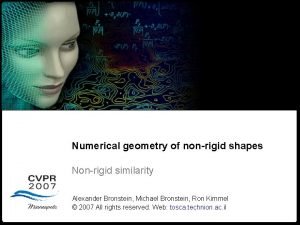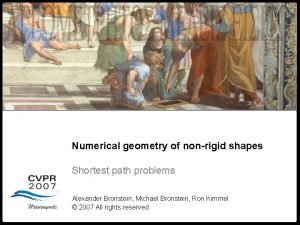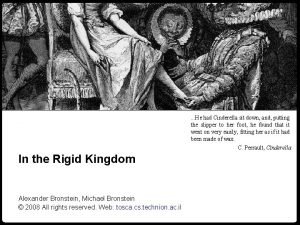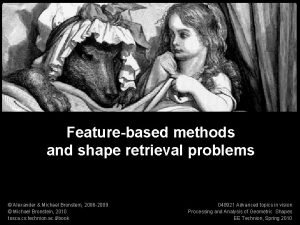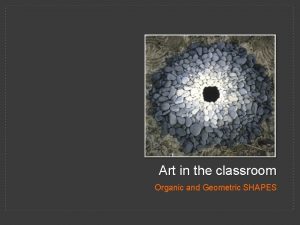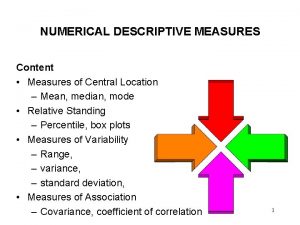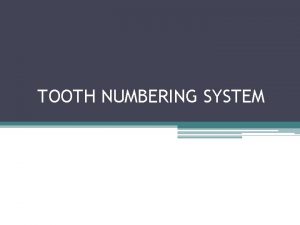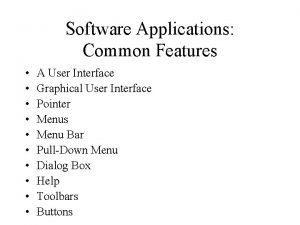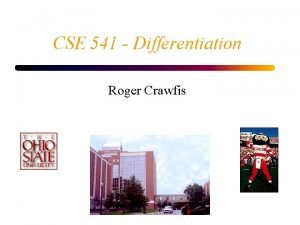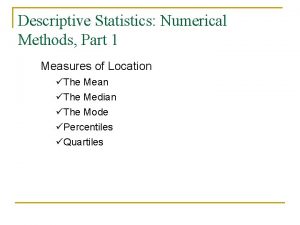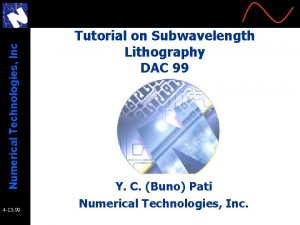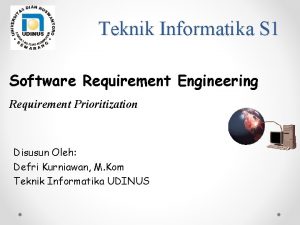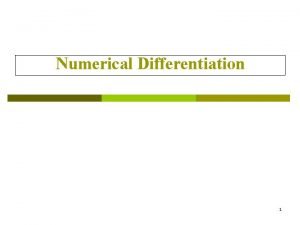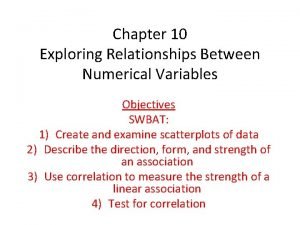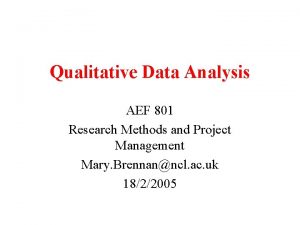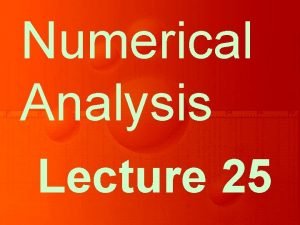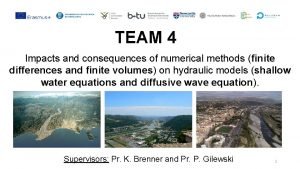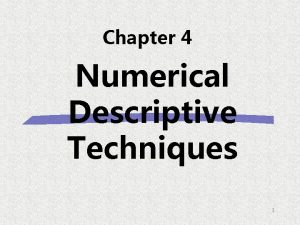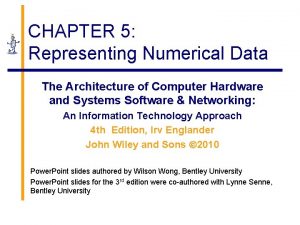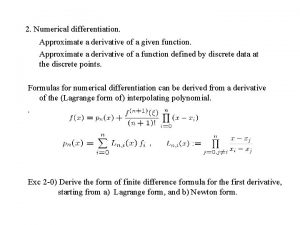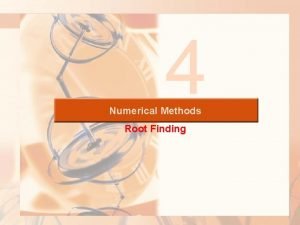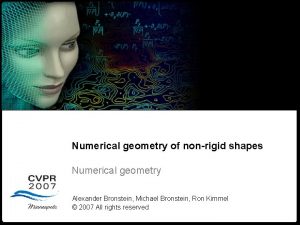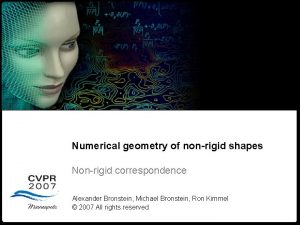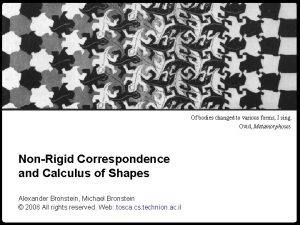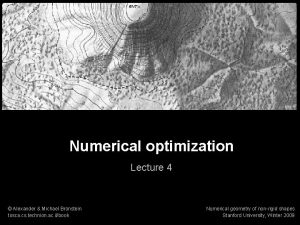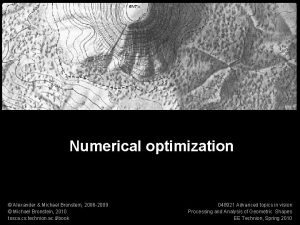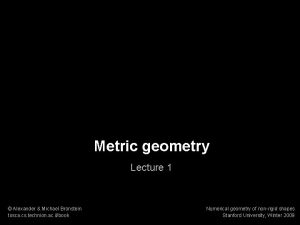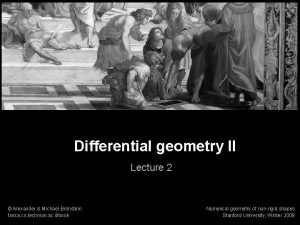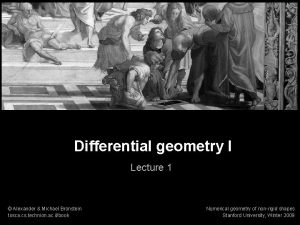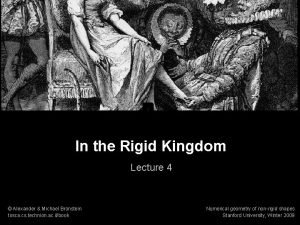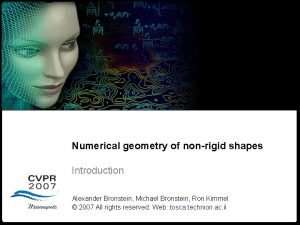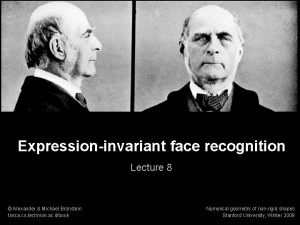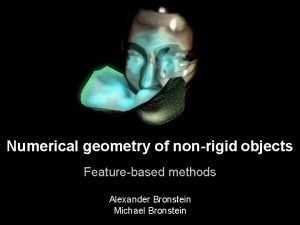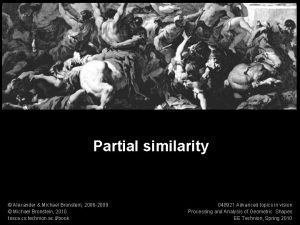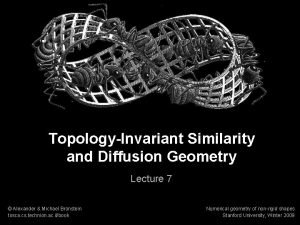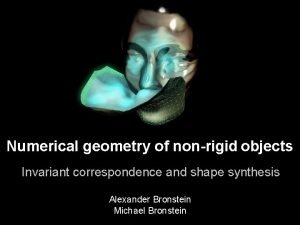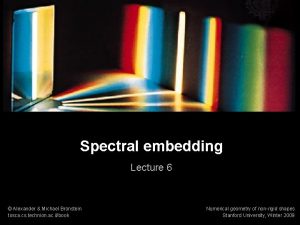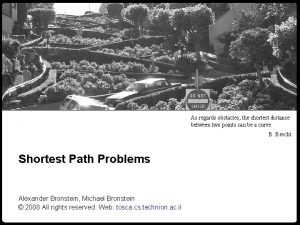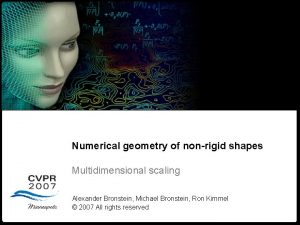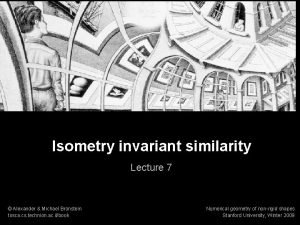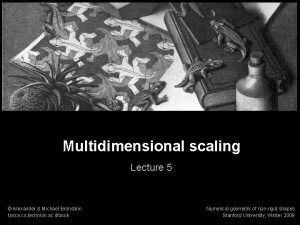Numerical geometry of nonrigid shapes Geometry Numerical geometry






























- Slides: 30

Numerical geometry of non-rigid shapes Geometry Numerical geometry of non-rigid shapes Shortest path problems Alexander Bronstein, Michael Bronstein, Ron Kimmel © 2007 All rights reserved 1

Numerical geometry of non-rigid shapes Geometry Alexander Bronstein, Michael Bronstein, Ron Kimmel © 2007 All rights reserved 2

3 Numerical geometry of non-rigid shapes Geometry Manifolds n We model our objects as two-dimensional manifolds n A two-dimensional manifold is a space, in which every point has a neighborhood homeomorphic to an open subset of (disk) n A manifold may have a boundary containing points homeomorphic to a subset of (half-disk) n Manifold is a topological object Manifold with Not a manifold Manifold boundary

Numerical geometry of non-rigid shapes Geometry Embedded surfaces n Surface of a tangible physical object is a two-dimensional manifold n Surface is embedded in the ambient Euclidean space n We can often create a smooth local system of coordinates (chart) for some portion of the surface n Parametric surface: a single system of coordinates in some parametrization domain is available for the entire surface 5

Numerical geometry of non-rigid shapes Geometry Example: parametrization of the Earth Latitude Longitude 6

Numerical geometry of non-rigid shapes Geometry Embedded surfaces n Derivatives and of the chart span a local tangent space n and create a local (non-orthogonal) system of coordinates n Normal to the surface is perpendicular to the tangent space 7

Numerical geometry of non-rigid shapes Geometry Metric n To create a geometry, we need the ability to measure distance n Formally, we define a metric n There are many ways to define a metric on n Restricted metric: measure Euclidean distance in ambient space n Defines extrinsic geometry – the way the surface is laid out in ambient space 8

9 Numerical geometry of non-rigid shapes Geometry Restricted vs. intrinsic metric Restricted metric Intrinsic metric

Numerical geometry of non-rigid shapes Geometry 10 Metric n Induced or intrinsic metric: measure the shortest path length on the surface where is a path with n Defines intrinsic geometry, experienced by a bug living on the surface and not knowing about the ambient space n The space is called complete if the shortest path exists n Shortest path realizing is called minimal geodesic

Numerical geometry of non-rigid shapes Geometry An extrinsic view n path in the parametrization domain n corresponding path on the surface n Increment by in time n Displacement by in the parametrization domain n Displacement on the surface by n Jacobian of the parametrization 12

Numerical geometry of non-rigid shapes Geometry An extrinsic view n Distance traveled on the surface n 2 x 2 positive definite matrix is called the first fundamental form n Fully defines the intrinsic geometry n Path length is given by 13

Numerical geometry of non-rigid shapes Geometry 14 An intrinsic view n In our definitions so far, intrinsic geometry relied on the ambient space n Instead, think of our object as an abstract manifold immersed nowhere n We define a tangent space at each point and equip it with an inner product called the Riemannian metric n Path length on the manifold is expressed as n Riemannian metric is coordinate free n Once a coordinate system is selected, it can be expressed using the first fundamental form coefficients n No more extrinsic geometry

Numerical geometry of non-rigid shapes Geometry 15 Nash’s embedding theorem n Seemingly, the intrinsic definition is more general n In 1956, Nash showed that any Riemannian metric can be realized as an embedded surface in a Euclidean space of sufficiently high but finite dimension n Nash’s embedding theorem implies that intrinsic and extrinsic views are equivalent

Numerical geometry of non-rigid shapes Geometry 16 Isometries n Two geometries and are indistinguishable, if there exists a mapping which is n Metric preserving: n Surjective: n Such a mapping is called an isometry n and are said to be isometric n is called a self-isometry

17 Numerical geometry of non-rigid shapes Geometry Isometry group n Composition of two self-isometries is a self-isometry n Self-isometries of form the isometry group, denoted by n Symmetric objects have non-trivial isometry groups A B C Trivial group: asymmetric AB C A AA CB CB Cyclic group: reflectional symmetry CACB CA B B Permutation group: Roto-reflectional symmetry

Numerical geometry of non-rigid shapes Geometry 18 Congruence n Isometry group of are translation, rotation and reflection transformations (congruences) n Congruences preserve the extrinsic geometry of an object n What are the transformations preserving the intrinsic geometry? n Extrinsic geometry fully defines intrinsic geometry n Hence, intrinsic geometry is invariant to congruences n Are there richer transformations? n Can a given intrinsic geometry have different incongruent realizations as an embedded surface?

Numerical geometry of non-rigid shapes Geometry Bending n Some objects have non-unique embedding into n Given two embeddings and of some intrinsic geometry n An isometry is called a bending n A bendable object may have different extrinsic geometries, while having the same intrinsic one 19

Numerical geometry of non-rigid shapes Geometry Try bending these bottles… n Transformation between and necessarily involves cutting n There is no physical way to apply one bottle to another n No continuous bending exists 20

Numerical geometry of non-rigid shapes Geometry Continuous bending n For some objects, there exists a continuous family of bendings such that n Object can be physically applied to without stretching or tearing n Such objects are called applicable or continuously bendable 21

Numerical geometry of non-rigid shapes Geometry 22 Rigidity n Objects that cannot be bent are rigid n Rigid objects have their extrinsic geometry completely defined (up to a congruence) by the intrinsic one n Rigidity interested mathematicians for centuries n 1766 Euler’s Rigidity Conjecture: every polyhedron is rigid n 1813 Cauchy proves that every convex polyhedron is rigid n 1927 Cohn-Vossen shows that all surfaces with positive Gaussian curvature are rigid n 1974 Gluck shows that almost all triangulated simply connected surfaces are rigid, remarking that “Euler was right statistically” n 1977 Connelly finally disproves Euler’s conjecture

Numerical geometry of non-rigid shapes Geometry 23 Rigidity n These results may give the impression that the world is more rigid than non-rigid n This is probably true, if isometry is considered in the strict sense n Many objects have some elasticity and therefore can bend n To account for this, the notion of isometry needs to be relaxed

Numerical geometry of non-rigid shapes Geometry Bi-Lipschitz mappings n Relative distortion of the metric is bounded n Lipschitz constant is called the dilation of n Bi-Lipschitz mapping is bijective n Preserves topology n Absolute change in large distances is larger n Unsuitable to model objects with little elasticity 24

Numerical geometry of non-rigid shapes Geometry Almost-isometries n Absolute distortion of the metric is bounded n Map is almost surjective n On large scales behaves almost like an isometry n On small scales, may have arbitrarily bad behavior n May be discontinuous n Does not necessarily preserve topology n Suitable for modeling objects with no or little elasticity 25

26 Numerical geometry of non-rigid shapes Geometry Bi-Lipschitz mappings vs almost-isometries Bi-Lipschitz mapping Almost-isometry

Numerical geometry of non-rigid shapes Geometry 27 Curvature n Determines how the object is different from being flat n Measures how fast the normal vector rotates as we move on the surface n Positive curvature: normal rotates in the direction of the step n Negative curvature: normal rotates in the opposite direction n At each point, there usually exist two principal directions, corresponding to the largest and the smallest curvatures and n Mean curvature: n Gaussian curvature:

Numerical geometry of non-rigid shapes Geometry 28 Curvature n Gaussian curvature is defined as product of principal curvatures n Alternative definition: measure the perimeter of a small geodesic ball of radius on the surface n Up to the second order, the result will coincide with the Euclidean one n The third order term is controlled by the Gaussian curvature n Perimeter can be measured by a bug living on the surface and knowing nothing about the ambient space n Gaussian curvature is an intrinsic quantity!

Numerical geometry of non-rigid shapes Geometry 29 Theorema Egregium theorema: si superficies curva in quamcunque aliam superficiem explicatur, mensura curvaturae in singulis punctis invariata manet. Carl Friedrich Gauss (1777 -1855)

Numerical geometry of non-rigid shapes Geometry Intrinsic invariants n Gaussian curvature of two isometric objects coincides at corresponding points n Can be used as an isometry-invariant descriptor n Problem: requires correspondence to be established 30

Numerical geometry of non-rigid shapes Geometry Global invariants n Possible way around: integrate over the whole surface n Quantity known as the Euler characteristic n Still invariant to isometries n Topological rather than geometric n Too crude to recognize between objects 31

Numerical geometry of non-rigid shapes Geometry 32 Conclusions so far… n Non-rigid world can be modeled using almost-isometries n Extrinsic geometry is invariant to rigid deformations n Intrinsic geometry is invariant to isometric deformations n Comparison of non-rigid objects = comparison of intrinsic geometries n We need numerical tools to n compute intrinsic quantities n compare intrinsic quantities
 Rigid vs non rigid transformations
Rigid vs non rigid transformations Numerical geometry of non-rigid shapes
Numerical geometry of non-rigid shapes Numerical geometry of non-rigid shapes
Numerical geometry of non-rigid shapes Non rigid transformation
Non rigid transformation Numerical geometry of non-rigid shapes
Numerical geometry of non-rigid shapes Non rigid
Non rigid Organic and geometric shapes
Organic and geometric shapes Bond angle
Bond angle Theory of structures
Theory of structures Electron domain geometry vs molecular geometry
Electron domain geometry vs molecular geometry This molecule is
This molecule is Numerical descriptive measures
Numerical descriptive measures Different types of tooth numbering system
Different types of tooth numbering system Programs that organize analyze and graph numerical data
Programs that organize analyze and graph numerical data Numerical differentiation
Numerical differentiation Numerical descriptive statistics
Numerical descriptive statistics What is a numerical expression
What is a numerical expression Numerical analysis
Numerical analysis Numerical aperture in microscope
Numerical aperture in microscope Numerical technologies ltd
Numerical technologies ltd Numerical assignment
Numerical assignment 1st derivative rule for forward and backward
1st derivative rule for forward and backward Numerical identity
Numerical identity Relationships between two numerical variables
Relationships between two numerical variables Counterdiscipline
Counterdiscipline Interpolation
Interpolation Numerical method
Numerical method Jack in
Jack in Representing numerical data
Representing numerical data Numerical differentiation
Numerical differentiation Fixed point iteration method
Fixed point iteration method
